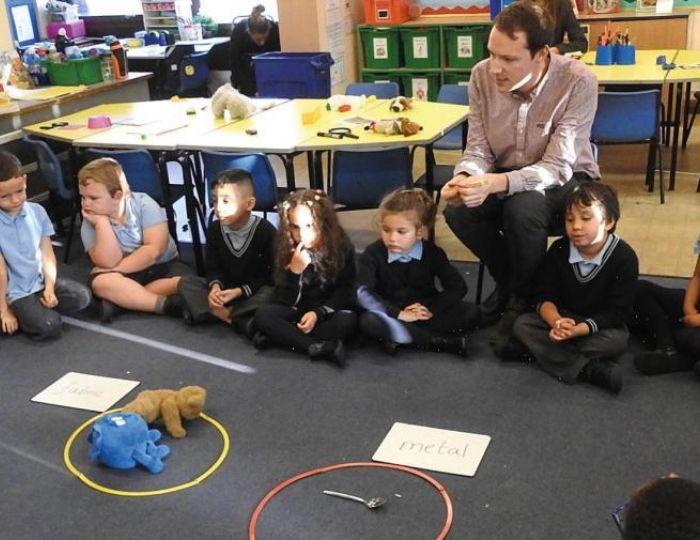It’s always the same. You know your Ofsted inspection is coming, yet it’s always a surprise.
“PHONE…! Ofsted!!!” A member of the office staff hurries in. They look startled and announce that Ofsted’s on the phone, their voice several octaves higher than usual.
There then follows 20 seconds or so of a dreamlike state, where my brain struggles to compute this massive thing that’s happening on some otherwise idle Tuesday RIGHT NOW. And so it begins.
Prepared, not obsessed
I’ve now had three Ofsted inspections as a headteacher: two full Section 5 inspections and another ‘light touch’ single day, single inspector Section 8 inspection.
All these Ofsted inspections have been different experiences, and all have ended well. I don’t believe we, as schools, should be obsessing over our next Ofsted inspection. However, nor do I think we should allow ourselves to be entirely unprepared.
I’m of the belief that you need to plan and control your Ofsted inspection process, lest it end up controlling you. Here, then, is my advice on preparing for and then managing, your next Ofsted inspection.
Before the Ofsted inspection call
1. Don’t obsess over Ofsted
A fellow headteacher once said to me, “I’d like to make the curriculum more exciting, but I could have an Ofsted inspection in 18 months and we’ve got to prepare.”
Why? Has Ofsted ever told us to spend months, or even years, preparing for our next inspection? Ofsted wants children to do well at school, and so do we!
If we run our schools well, and if children achieve, then Ofsted will be perfectly happy.
2. Don’t do things ‘for Ofsted’
Many get caught up in doing what we think Ofsted wants us to do. Schools can get so busy creating a safeguarding paper trail that they forget to actually keep children safe.
Safeguarding does involve lots of paperwork. However, our chief goal must be to create a culture of safety, not please Ofsted.
Get it right, and we succeed at both. Get it wrong, and we leave children in danger.
3. Understand the criteria
Ofsted’s school inspection handbook is a public document every headteacher should read cover to cover. Pay special attention to the bullet points explaining exactly what an inspector will inspect and the evidence they’ll be looking for.
4. Tell a coherent story
You must complete a succinct self- evaluation form that tells the story of the school accurately, coherently and honestly.
Start by explaining your school’s context and any special provision or aspect of the student population you need the Ofsted inspector to understand. Then write your SEF using the same area headings as those in the Ofsted handbook.
5. Annotate your IDSR
Ofsted’s inspection data summary report is the only data your inspector will have looked at before visiting your school.
Rightly or wrongly, that’s the data that matters most to them. Take time to fully understand the data in the report and prepare arguments for any weak spots.
We found it useful to digitally annotate our school’s IDSR by adding pop-up comment boxes beside the relevant data, which is easy to do on a PDF document.
This helps your governors understand said data and provides leaders with helpful prompts when meeting with Ofsted inspectors.
At our last full Ofsted inspection we sent these annotations to the inspector after our initial phone call. This answered many of their questions before they even arrived and allowed more inspection time for the things we wanted to celebrate.
6. Create an ‘Ofsted readiness plan’
That period of time between the lunchtime phone call and the start of the Ofsted inspection is crucial, so plan in advance what you’ll use it for.
Ahead of our latest inspection I had an ‘Ofsted readiness plan’ pinned to my noticeboard, reminding me of all the things that needed to happen that afternoon in order for the school to be ready for inspection.
If you just follow your plan, everything that needs to happen will get done.
When you get the Ofsted inspection call
7. Declare your position
The initial Ofsted inspection phone call will centre on practicalities. Most inspectors will have decided on their preliminary inspection trails by the time they call you, so make sure you ask what these are and prepare to counter them.
If you’ve studied your IDSR and know your data, they shouldn’t come as a surprise. At this point I like to make my position clear.
Ahead of our latest Section 8 inspection, I told the Ofsted inspector I wanted the school to be considered for an early Section 5, as we felt we had tipped over into Outstanding.
Telling the inspector your position lets them know you’ll be managing the Ofsted inspection alongside them – not just letting it ‘happen to you’.
8. Agree the party line
The first thing I do when I get off the phone with the inspector is arrange a meeting with the SLT during the afternoon to discuss the data and evidence we’ll need to counter the Ofsted inspection trails.
We’ll also read through the SEF, ensuring everyone understands the key messages. We then allocate SLT members to each teacher, who’ll go and check their classrooms and plans for the following day to ensure there are no surprises.
9. Speak the inspector’s language
When training as an Ofsted inspector myself, what struck me most was the pace at which an inspector has to get through their tasks and the discipline needed to keep to time.
You might want to tell the Ofsted inspector about your fabulous dance or art provision. However, unless they’re asking about the arts curriculum they’re unlikely to be interested.
Section 8 inspections are intense. Where a Section 5 looks at everything, a Section 8 will focus on your biggest weakness.
Reading the Ofsted inspection handbook with your weakest area in mind will give you an indication of what the inspection will look like.
Don’t worry about folders of evidence – Ofsted don’t want to see these now, especially on a Section 8. Just know where your school’s evidence is and stick to the point.
10. Get your safeguarding right
There’s no excuse for messing up on safeguarding during an inspection, and no flexibility – fail this and you fail the inspection.
Make sure your Single Central Record is up-to-date, has no gaps and is regularly checked. Your statutory policies and school safeguarding procedures and practices should be clear and understood by all staff.
Inspectors want to know that everything practicable is being done to keep children safe, not just that you have a piece of paper that says to.
On the day of your Ofsted inspection
11. Stick to your guns
Often an Ofsted inspector will prod a headteacher to see if they’ll stick to their guns when pushed or simply concede that they’re wrong.
There’s no point being delusional – if your data clearly says one thing, it’s hard to argue the opposite. However, don’t give up on a point too easily.
Don’t be rude or aggressive, but ask the inspector, “What evidence would you like me to show you to convince you that I’m right?”.
Ofsted isn’t some all seeing eye. The inspector will be constantly shifting their opinion as the Ofsted inspection proceeds, so keep providing evidence if you think they’ve got the wrong end of the stick.
12. Be honest
I’ve never seen a school leader come unstuck by telling the truth. I’ve seen many come unstuck by trying to hide things.
During one Osted inspection when I was a shadow inspector, the school told me that an outgoing teacher had ‘lost’ the previous year’s EYFS data.
When I pressed the current EYFS teacher on this, they eventually admitted that they did have it, but had been told to say they didn’t.
The look on the head’s face when, after their repeated denials of its existence, I placed a copy of it on the table was priceless – and unnecessary. Don’t lie. It’ll end badly.
13. It’s not over until it’s over
An inspector might say they want to be heading home by 4pm, but that doesn’t have to be the case.
During our Section 8 we were still arguing with the inspector as to whether the school should have an early Section 5 at 6pm. We lost that argument, but it didn’t stop us providing evidence until the very last minute.
14. Push for positive tweaks
A week or so after the Ofsted inspection you’ll receive a draft letter or report, depending on whether you had a Section 8 or Section 5.
If the inspector described your curriculum as ‘Outstanding’ on the day, but the report has it as ‘excellent’, ask that this be changed.
These little tweaks might seem trivial, but you’ll have to live with this report for the next three to five years, so it may as well be right.
Example Ofsted inspection readiness plan
12:30pm
Receive phone call; send note around classes asking for brief meeting in staffroom at 1pm to share trails
12:40pm
Arrange afternoon supply cover for SLT
12:45pm
Notify chair of governors, LA and SIA and arrange their meetings with the lead inspector
1pm
Brief staff and request following day’s timetables
1:15pm
Call all governors and request 6pm meeting
1:30pm
SLT meeting – discuss trails, consider likely questions and evidence needed; Read through SEF and IDSR and check everyone understands key data/evidence
2:45pm
Hold whole school assembly – remind the children what champions look like!
3:30pm
HT and SBM meet with safeguarding governor to check single central record and other key documents
3:45pm
SLT meet individually with teachers to calm nerves, check learning environments and talk through following day’s lessons
6pm
Governors’ meeting – share Ofsted trails and check who’s available to meet with inspector (ideally three or four members); Discuss IDSR, in-school data, SEF and SDP, along with performance of vulnerable groups
8pm
Send everyone home
Simon Botten is a primary school headteacher; follow him at @Southgloshead or visit southgloshead.wordpress.com










